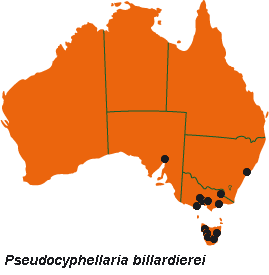



Australian Biological Resources Study
| Checklist of the Lichens of Australia and its Island Territories | ||
| Introduction | A–D | E–O | P–R | S–Z | Oceanic Islands | References | ||
| Pseudocyphellaria billardierei (Delise) Räsänen | ||
| Ann. Bot. Soc. Zool.-Bot. Fenn. "Vanamo" 2(1): 39 (1932). Sticta billardierei Delise, Mém. Soc. Linn. Calvados 2: 99, pl. 8, fig. 35 ('1822') [1825]; Sticta faveolata var. billardierei (Delise) C.Bab., in J.D.Hooker, Fl. Nov. Zel. 2: 278 (1855); Sticta cellulifera var. billardierei (Delise) Hue, Nouv. Arch. Mus. Hist. Nat., sér. 3, 2: 306 (1890); Lobaria billardierei (Delise) Hellb., Bih. Kongl. Svenska Vetensk.-Akad. Handl. 21(3/13): 41 (1896). T: Cap Van Diemen, [Tas.], J.-J.H. de Labillardière ex Herb Dufour; lecto: PC-LENORMAND, fide D.J.Galloway & P.W.James, Lichenologist 12: 293 (1980); isolecto: FI-WEBB, PC-MONTAGNE. ***** Sticta flotowiana Laurer, Linnaea 2: 40 (1827); Pseudocyphellaria flotowiana (Laurer) Malme, Bih. Kongl. Svenska Vetensk. Akad. Handl. 25(3/6): 22 (1899). T: Nova Hollandia [Australia], s. loc., F.Sieber; lecto: BM, fide D.J.Galloway & P.W.James, Lichenologist 12: 298 (1980); isolecto: M. ***** Sticta linearis Hook.f. & Taylor, London J. Bot. 3: 647 (1844). T: Lord Auckland's Group [Auckland Is.], J.D.Hooker; lecto: BM, fide D.J.Galloway, Bull. Brit. Mus. (Nat. Hist.), Bot. 17: 75 (1988). | ||
| Thallus irregularly spreading, somewhat entangled, loosely attached centrally, 5–15 (–30) cm wide; margins free, ±ascending. Lobes linear-elongate, dichotomously branching, often widely divergent at apices, 2–6 (–10) cm long, 2–15 (–30) mm wide, plane to canaliculate; lobe margins entire, thickened-ridged below (×10 lens), without projecting pseudocyphellae. Upper surface grey-green to olive-brownish when dry, lettuce-green when wet, shallowly to deeply faveolate; without isidia, maculae, phyllidia, pseudocyphellae or soredia. Medulla white. Photobiont green. Lower surface wrinkled to bullate, pale and glabrous at margins, darker centrally, with a scattered to uniform tomentum. Pseudocyphellae minute, white, Apothecia marginal, rarely laminal, sessile, 0.5–5 mm diam.; disc dark red-brown to black, epruinose; exciple corrugate-scabrid, pale buff to red-brown. Ascospores ellipsoidal, 1-septate, 25–32 (–38) × 9–11.5 μm, brown or grey; walls thickened. CHEMISTRY: Methyl evernate, tenuiorin, 2"-O-methyltenuiorin, 2',2"-di-O-methyltenuiorin, methyl gyrophorate, methyl lecanorate, gyrophoric acid (trace), norstictic acid, stictic acid, cryptostictic acid (trace), 9α-acetylconstictic acid (trace), constictic acid and zeorin. |
 |
|
| Occurs in S.A., eastern N.S.W., Vic. and Tas.; grows on living and dead wood, tree trunks, canopy branches and shrubs in sheltered forest, occasionally also on rocks in ±open forest, at altitudes of 200–1540 m. Widespread in New Zealand from latitude 35°S southwards to the Auckland Is. and Campbell Is. | ||
| Galloway et al. (2001) | ||
| Checklist Index |
| Introduction | A–D | E–O | P–R | S–Z | Oceanic Islands | References |
This work is copyright. Apart from any use as permitted under the Copyright Act 1968, no part may be reproduced by any process without prior written permission from Australian Biological Resources Study. Requests and inquiries concerning reproduction and rights should be addressed in the first instance to Dr P. McCarthy. These pages may not be displayed on, or downloaded to, any other server without the express permission of ABRS.